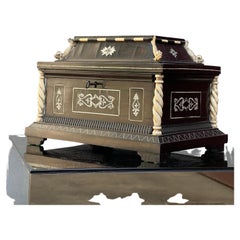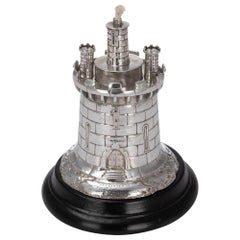Ebony Boxes
to
17
86
36
2
18
46
22
38
9
9
2
2
2
1
3
2
1
24
13
9
5
4
4
3
1
1,814
5,160
4,244
1,560
1,510
58
54
89
30
25
19
18
Height
to
Width
to
124
102
104
12
6
6
5
3
Material: Ebony
Anglo-Indian Padouk Box
Located in London, GB
An Anglo-Indian brass-mounted padouk and ebony box, Ceylon, second half of the 18th century.
Category
18th Century Antique Ebony Boxes
Materials
Brass
$2,991
Italian 19th Century Florentine St. Ebony and Pietra Dura Marble Box
Located in West Palm Beach, FL
A charming and extremely decorative Italian 19th century Florentine st. Ebony and Pietra Dura marble box. The box is raised by an elegant stepped mottled base with striking wonderful...
Category
19th Century Italian Antique Ebony Boxes
Materials
Marble
antica scatola in legno di ebano e osso - antichita - prima meta 19 secolo
Located in Milano, MI
antica scatola in legno di ebano e osso - antichita - prima meta 19 secolo
Stile: rinascimentale
Epoca: 1850
Origine: Italia
Materiale: Legno e osso
Descrizione ...
Category
1850s Italian Antique Ebony Boxes
Materials
Ebony
19th Century Victorian Solid Silver Guard Tower Table Lighter, London, c.1878
Located in Royal Tunbridge Wells, Kent
Antique 19th century Victorian novelty solid silver table lighter, unusually shaped as a "guard tower", realistically modelled with simulated brick-work, door and archers windows, wi...
Category
19th Century British Victorian Antique Ebony Boxes
Materials
Sterling Silver
Recently Viewed
View AllMore Ways To Browse
German Cigarette Case
Chinese Lacquer Sewing Box
Copper Trinket Box
Crane Box
Crystal Vanity Box
Enamel Box With Ball Feet
German Wooden Box
Iron Strong Box
Jeweled Box
Lapis Silver Box
Limoges Castel
Marble And Brass Box
Morocco Silver Box
Rose Water Bottle
Swedish Bentwood Box
Tiffany Zodiac Box
Vintage Florentine Leather
Vintage Metal Box With Lid



